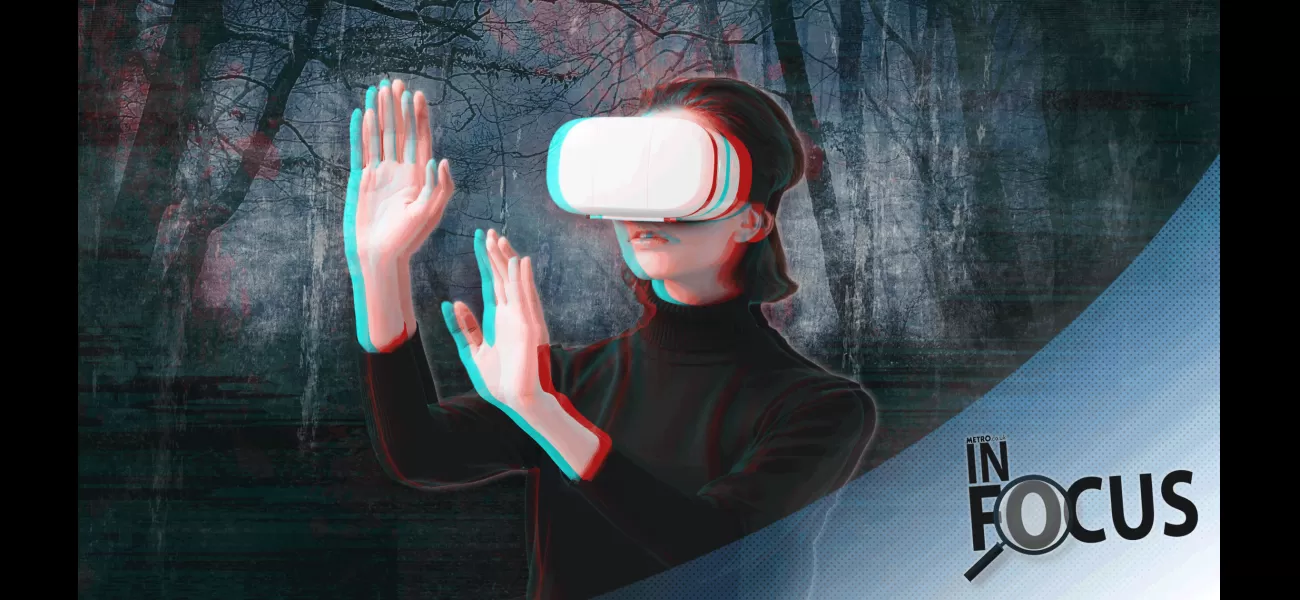Being sexually assaulted in a virtual world is a terrifying experience.
YouTube has instructional videos on a 'rape hack' that allows users to manipulate someone else's avatar.
January 13th 2024.

The world of virtual reality, also known as the metaverse, is a place where real and digital worlds merge into one. It's a space where anyone can become anyone, and anything is possible. But, just like in the real world, there are dangers lurking in the shadows. These dangers may seem harmless at first, but they can have very real and damaging consequences.
One such danger is virtual assault. In the metaverse, avatars roam free, their identities hidden behind faceless cartoon characters. This anonymity can make it difficult to discern the intentions of others, and the content they are creating. However, if you look closely, you may come across disturbing videos, like the one that shows how to execute a "rape hack" on the popular game Roblox. Despite being taken down, this video is just one of many that reflect a concerning trend of online sexual assault. The attacks may take place in cyberspace, but the trauma and impact on the victims are very real.
Recently, there was a case of virtual rape in the metaverse that made headlines. A young girl was virtually assaulted by a group of male avatars while exploring the virtual world. The experience left her with severe emotional trauma, and unfortunately, this is not an isolated incident. Virtual assaults like these are becoming more common, and they can have lasting effects on the victims.
Nina Jane Patel, a psychotherapist, experienced a similar attack while exploring the virtual world of Horizon Venues. In just 60 seconds, her avatar was virtually gang-raped, leaving her with a sense of panic and shock. She compared the experience to being physically attacked on the street. The virtual world may seem like a safe space, but the mind and body cannot always differentiate between virtual and real experiences.
The concept of the metaverse, where the real and virtual worlds become one, may seem like something out of a science fiction novel. But, children as young as five years old are already exploring this virtual world through VR headsets. Companies are banking on the metaverse becoming a part of our daily lives, especially for the next generation, as technology continues to advance.
Nina, who has been a victim of virtual assault, is now an advocate for legislation to protect children online. She continues to research the good, the bad, and the ugly of the virtual world and raises awareness about its potential dangers. In her original blog post about her assault, she described feeling frozen and trapped in a nightmare, despite being physically safe in her own living room.
So, what exactly is the metaverse? The word itself is a combination of "meta," meaning beyond, and "universe." It's a shared online space where individuals can explore and interact with others through their avatars. These avatars are representations of ourselves in the virtual world, and we can meet and engage with others through various platforms and games.
The NSPCC estimates that 15% of children between the ages of five and ten have used a VR headset, and 6% use it daily. Companies are hoping to attract younger audiences to the metaverse as technology continues to improve. However, as we can see from the disturbing videos and attacks, this technology also has its dark side.
Nina believes that it was only a matter of time before the police had to investigate a case of virtual assault. The victim in this case showed incredible bravery by coming forward and reporting the attack. She is breaking ground and shedding light on a concerning issue that needs to be addressed. Virtual assault may occur in a virtual setting, but the psychological consequences are very real. The immersive nature of the metaverse can make the experiences feel just as intense as real-life events.
Sadly, virtual assaults are not limited to the metaverse. In 2018, a mother watched in horror as her child's character was virtually gang-raped in the game Roblox. The attack was so violent that the child's avatar was left lying on the ground. Shockingly, there are even videos on YouTube that show how to execute a "rape hack" in the game. One video, uploaded by a user with a cartoon avatar, has been viewed over 38,000 times before it was taken down.
Catherine Hamilton-Giachritsis, an academic specializing in child psychology, has been researching online sexual abuse for over a decade. She was horrified when she saw the "rape hack" video and believes that it may have been created by a child due to its cartoonish nature. The fact that such content is so accessible on YouTube is shocking. Catherine explains that there is less accountability in virtual games, which leads to users acting in ways they never would in the real world.
Furthermore, with the advancements of VR technology, it can be easy to forget that you are wearing a headset and fully immerse yourself in the virtual world. A study by Stanford found that younger children may even struggle to distinguish between virtual and real memories, creating a false sense of reality. So, it's not as simple as just taking off the headset or pressing an escape button, as some may suggest. These comments only serve to blame the victim, and they fail to understand the impact of virtual assaults.
The virtual world may seem like a harmless escape from reality, but for some, it can turn into a nightmare. As technology continues to advance, we must address the potential dangers of the metaverse and protect those who explore it, especially children.
The virtual world, also known as the metaverse, has become a popular platform for people to connect and interact with each other. However, it has also become a breeding ground for disturbing and harmful activities that can have real-life consequences. This was highlighted when a video showing children how to perform a "rape hack" on the game Roblox went viral on YouTube. Although the video was later taken down, it revealed a disturbing trend of online sexual assault that is often overlooked or dismissed due to the virtual nature of the attacks.
Recently, a 16-year-old girl was virtually raped within the metaverse, sparking a police investigation. She was surrounded by a group of male avatars as she explored the virtual world, an experience that left her with emotional trauma. Sadly, this was not an isolated incident and it is likely that more attacks will occur in the future. Psychotherapist Nina Jane Patel, who was herself a victim of virtual rape, understands the severity and lasting impact of such attacks. She knows all too well that simply "taking off the headset" is not enough to escape the psychological effects of virtual assault.
The metaverse is a shared online space where real and digital worlds merge into one. Users can explore this world through their avatars, interacting with others and participating in various activities. It is estimated that 15% of children between the ages of five and ten have used a virtual reality headset, and 6% use one daily. As technology continues to improve, companies hope to attract even younger audiences to the metaverse.
Nina Patel, who has been a vocal advocate for legislation to protect children online, bravely shared her own experience of virtual rape within the metaverse. In her blog post, she described feeling "frozen" and trapped in a "nightmare" despite being physically safe in her living room. This highlights the immersive nature of the metaverse, where the mind and body cannot differentiate between virtual and real experiences.
However, the metaverse is not the only place where such attacks are taking place. In 2018, a mother watched in horror as her child's character was violently gang-raped by male avatars in the game Roblox. Disturbingly, there are videos on YouTube that teach viewers how to perform a "rape hack" within the game. Despite being taken down, these videos can still be found and can have a damaging impact on young viewers.
Catherine Hamilton-Giachritsis, an academic with expertise in child psychology, was horrified when she saw one of these videos. She believes that some of the views on these videos are from children who may not fully understand the gravity of what they are watching. The anonymity and lack of consequences in the virtual world can also lead to harmful behavior that would not occur in the offline world.
Moreover, the immersive nature of virtual reality can make it difficult for users to differentiate between virtual and real experiences. A study has shown that younger children can even develop false memories in virtual reality. Therefore, it is unfair to blame victims of virtual assault for not simply "taking off the headset" or pressing an escape button. These attacks can have the same impact as offline attacks, causing trauma and psychological distress.
In conclusion, while the metaverse offers endless possibilities for connection and exploration, it also poses a real threat to the safety and well-being of its users. It is important for parents, companies, and authorities to recognize this issue and take necessary steps to protect children and prevent such attacks from happening in the future. As the line between virtual and real life continues to blur, it is crucial to address the potential consequences of virtual actions and create a safe and responsible online environment.
One such danger is virtual assault. In the metaverse, avatars roam free, their identities hidden behind faceless cartoon characters. This anonymity can make it difficult to discern the intentions of others, and the content they are creating. However, if you look closely, you may come across disturbing videos, like the one that shows how to execute a "rape hack" on the popular game Roblox. Despite being taken down, this video is just one of many that reflect a concerning trend of online sexual assault. The attacks may take place in cyberspace, but the trauma and impact on the victims are very real.
Recently, there was a case of virtual rape in the metaverse that made headlines. A young girl was virtually assaulted by a group of male avatars while exploring the virtual world. The experience left her with severe emotional trauma, and unfortunately, this is not an isolated incident. Virtual assaults like these are becoming more common, and they can have lasting effects on the victims.
Nina Jane Patel, a psychotherapist, experienced a similar attack while exploring the virtual world of Horizon Venues. In just 60 seconds, her avatar was virtually gang-raped, leaving her with a sense of panic and shock. She compared the experience to being physically attacked on the street. The virtual world may seem like a safe space, but the mind and body cannot always differentiate between virtual and real experiences.
The concept of the metaverse, where the real and virtual worlds become one, may seem like something out of a science fiction novel. But, children as young as five years old are already exploring this virtual world through VR headsets. Companies are banking on the metaverse becoming a part of our daily lives, especially for the next generation, as technology continues to advance.
Nina, who has been a victim of virtual assault, is now an advocate for legislation to protect children online. She continues to research the good, the bad, and the ugly of the virtual world and raises awareness about its potential dangers. In her original blog post about her assault, she described feeling frozen and trapped in a nightmare, despite being physically safe in her own living room.
So, what exactly is the metaverse? The word itself is a combination of "meta," meaning beyond, and "universe." It's a shared online space where individuals can explore and interact with others through their avatars. These avatars are representations of ourselves in the virtual world, and we can meet and engage with others through various platforms and games.
The NSPCC estimates that 15% of children between the ages of five and ten have used a VR headset, and 6% use it daily. Companies are hoping to attract younger audiences to the metaverse as technology continues to improve. However, as we can see from the disturbing videos and attacks, this technology also has its dark side.
Nina believes that it was only a matter of time before the police had to investigate a case of virtual assault. The victim in this case showed incredible bravery by coming forward and reporting the attack. She is breaking ground and shedding light on a concerning issue that needs to be addressed. Virtual assault may occur in a virtual setting, but the psychological consequences are very real. The immersive nature of the metaverse can make the experiences feel just as intense as real-life events.
Sadly, virtual assaults are not limited to the metaverse. In 2018, a mother watched in horror as her child's character was virtually gang-raped in the game Roblox. The attack was so violent that the child's avatar was left lying on the ground. Shockingly, there are even videos on YouTube that show how to execute a "rape hack" in the game. One video, uploaded by a user with a cartoon avatar, has been viewed over 38,000 times before it was taken down.
Catherine Hamilton-Giachritsis, an academic specializing in child psychology, has been researching online sexual abuse for over a decade. She was horrified when she saw the "rape hack" video and believes that it may have been created by a child due to its cartoonish nature. The fact that such content is so accessible on YouTube is shocking. Catherine explains that there is less accountability in virtual games, which leads to users acting in ways they never would in the real world.
Furthermore, with the advancements of VR technology, it can be easy to forget that you are wearing a headset and fully immerse yourself in the virtual world. A study by Stanford found that younger children may even struggle to distinguish between virtual and real memories, creating a false sense of reality. So, it's not as simple as just taking off the headset or pressing an escape button, as some may suggest. These comments only serve to blame the victim, and they fail to understand the impact of virtual assaults.
The virtual world may seem like a harmless escape from reality, but for some, it can turn into a nightmare. As technology continues to advance, we must address the potential dangers of the metaverse and protect those who explore it, especially children.
The virtual world, also known as the metaverse, has become a popular platform for people to connect and interact with each other. However, it has also become a breeding ground for disturbing and harmful activities that can have real-life consequences. This was highlighted when a video showing children how to perform a "rape hack" on the game Roblox went viral on YouTube. Although the video was later taken down, it revealed a disturbing trend of online sexual assault that is often overlooked or dismissed due to the virtual nature of the attacks.
Recently, a 16-year-old girl was virtually raped within the metaverse, sparking a police investigation. She was surrounded by a group of male avatars as she explored the virtual world, an experience that left her with emotional trauma. Sadly, this was not an isolated incident and it is likely that more attacks will occur in the future. Psychotherapist Nina Jane Patel, who was herself a victim of virtual rape, understands the severity and lasting impact of such attacks. She knows all too well that simply "taking off the headset" is not enough to escape the psychological effects of virtual assault.
The metaverse is a shared online space where real and digital worlds merge into one. Users can explore this world through their avatars, interacting with others and participating in various activities. It is estimated that 15% of children between the ages of five and ten have used a virtual reality headset, and 6% use one daily. As technology continues to improve, companies hope to attract even younger audiences to the metaverse.
Nina Patel, who has been a vocal advocate for legislation to protect children online, bravely shared her own experience of virtual rape within the metaverse. In her blog post, she described feeling "frozen" and trapped in a "nightmare" despite being physically safe in her living room. This highlights the immersive nature of the metaverse, where the mind and body cannot differentiate between virtual and real experiences.
However, the metaverse is not the only place where such attacks are taking place. In 2018, a mother watched in horror as her child's character was violently gang-raped by male avatars in the game Roblox. Disturbingly, there are videos on YouTube that teach viewers how to perform a "rape hack" within the game. Despite being taken down, these videos can still be found and can have a damaging impact on young viewers.
Catherine Hamilton-Giachritsis, an academic with expertise in child psychology, was horrified when she saw one of these videos. She believes that some of the views on these videos are from children who may not fully understand the gravity of what they are watching. The anonymity and lack of consequences in the virtual world can also lead to harmful behavior that would not occur in the offline world.
Moreover, the immersive nature of virtual reality can make it difficult for users to differentiate between virtual and real experiences. A study has shown that younger children can even develop false memories in virtual reality. Therefore, it is unfair to blame victims of virtual assault for not simply "taking off the headset" or pressing an escape button. These attacks can have the same impact as offline attacks, causing trauma and psychological distress.
In conclusion, while the metaverse offers endless possibilities for connection and exploration, it also poses a real threat to the safety and well-being of its users. It is important for parents, companies, and authorities to recognize this issue and take necessary steps to protect children and prevent such attacks from happening in the future. As the line between virtual and real life continues to blur, it is crucial to address the potential consequences of virtual actions and create a safe and responsible online environment.
[This article has been trending online recently and has been generated with AI. Your feed is customized.]
[Generative AI is experimental.]
0
0
Submit Comment





